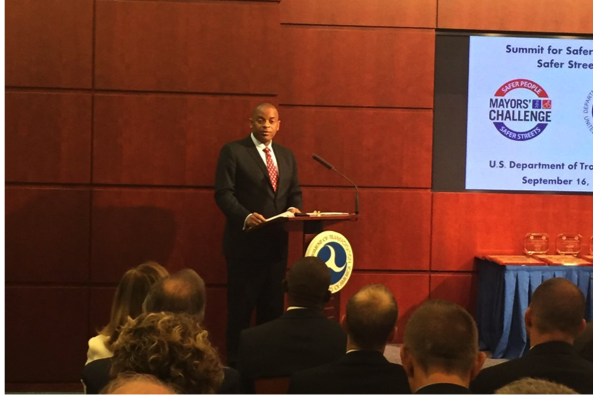September 30, 2016
The USDOT Mayors’ Challenge for Safer People, Safer Streets challenged city leaders to form local coalitions to increase safety for bicyclists and pedestrians in their communities. Across the United States, 245 communities participated in the Challenge across seven categories:
- Take a Complete Streets Approach
- Fix barriers to make streets safe and convenient for everyone
- Gather and track biking and walking data
- Design right for safety
- Create and complete pedestrian and bicycle networks
- Improve safety laws and regulations
- Educate and enforce proper road behavior by all
 On September 16, Secretary Anthony Foxx recognized the winners of the Mayors’ Challenge Awards, bringing city leaders from California to New York to speak about the success of their initiatives in reducing bicycle/pedestrian (bike-ped) fatalities, implementing complete streets approaches, connecting bike-ped networks, and eliminating barriers that cause community fragmentation.
On September 16, Secretary Anthony Foxx recognized the winners of the Mayors’ Challenge Awards, bringing city leaders from California to New York to speak about the success of their initiatives in reducing bicycle/pedestrian (bike-ped) fatalities, implementing complete streets approaches, connecting bike-ped networks, and eliminating barriers that cause community fragmentation.
Secretary Foxx acknowledged the importance of the federal government’s role in collaborating with states and localities to prevent traffic deaths and increase mobility across the nation.
“It is not easy to develop infrastructure for bicyclists and pedestrians,” he said, “This is an area of collective responsibility. We owe it to you. We will do our best to help inform and support you, and share best practices.”
The key takeaways from the panels and breakout sessions for improving bike-ped safety were:
- City leaders were inspired to form coalitions once they were provided with direction from USDOT for achieving specific livability goals in their communities;
- Cities performed best when they shared best practices with similar cities in their state and across the country;
- The most successful participants collaborated with metropolitan planning organizations (MPOs) and the federal government on the public side as well as local businesses on the private side to build shared goals and communicate the program’s benefits to all actors involved.
Solving Problems, Large and Small
The diversity of cities engaged in the challenge was emblematic of the growing national interest in increasing walking and biking options both in rural and urban areas.
Perhaps the best example of this was South Bend, Indiana, which received both the Overall Success award and Complete Streets award for small cities. The city’s participation in this challenge was a continuation of its 2014 Smart Streets Initiative first launched in 2014. Then, beginning in August 2015, the city convened a focus group that included local leaders, associations, and residents that chose the issues it wanted to address in the city.
Its leader – who affably suggests calling him “Mayor Pete” rather than struggling to pronounce his last name, Buttigieg – stressed that the revitalization of South Bend came about by taking a philosophical look at how and why cities exist.
“Why do we have streets in the first place? You could shoot a cannonball downtown and [it] wouldn’t hit anyone when I was a kid,” he laughed, “the 4 lane highway cutting through the middle of downtown was meant to evacuate, I want to populate!”
Collaborating with the Michiana Area Council of Governments (MACOG), the city collected data on bicycle crashes, demand for bike-ped facilities, and statistics on bicycle level of comfort and safety in the road network. From there, the city redesigned major arteries, implemented road diets (reducing lane size or number of lanes), and created separated bike facilities.
“Because of bad decisions in the 1960s and 70s, our downtown looked like a highway . . . so we made the city what we wanted,” said Mayor Pete.
Award Winners
Below is the complete list of all award recipients, with links to each of their success stories.
Secretary’s Awards:
Challenge Activity Awards:
- Take a Complete Streets Approach: Miami-Dade County, FL, and South Bend, IN
- Fix barriers to make streets safe and convenient for everyone: Myrtle Beach, SC
- Gather and track biking and walking data: Los Angeles, CA and Bellevue, WA
- Design right for safety: New York, NY, and Henderson, NV
- Create and complete pedestrian and bicycle networks: Lexington, KY, and Norwalk, CT
- Improve safety laws and regulations: Washington, DC
- Educate and enforce proper road behavior by all: Louisville, KY, and Oro Valley, AZ


 On September 16, Secretary Anthony Foxx recognized the winners of the Mayors’ Challenge Awards, bringing city leaders from California to New York to speak about the success of their initiatives in reducing bicycle/pedestrian (bike-ped) fatalities, implementing complete streets approaches, connecting bike-ped networks, and eliminating barriers that cause community fragmentation.
On September 16, Secretary Anthony Foxx recognized the winners of the Mayors’ Challenge Awards, bringing city leaders from California to New York to speak about the success of their initiatives in reducing bicycle/pedestrian (bike-ped) fatalities, implementing complete streets approaches, connecting bike-ped networks, and eliminating barriers that cause community fragmentation.


